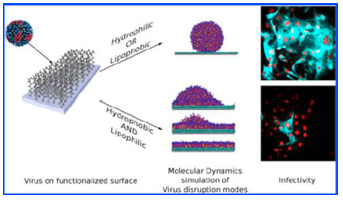Functionalized surfaces with tailored wettability determine influenza A infectivity
Functionalized surfaces with tailored wettability determine influenza A infectivity
I. Mannelli, R. Reigada, I. Suárez, D. Janner, A. Carrilero, P. Mazumder, F. Sagués, V. Pruneri, M. Lakadamyali.
ACS Applied Materials and Interfaces, 8 (2016) 15058.

The contact of a virus on a functionalized surface leads to a variety of interaction modes and eventually to the disruption of its lipidic envelope reducing the virus infectivity.
Surfaces contaminated with pathogenic microorganisms contribute to their transmission and spreading. The development of “active surfaces” that can reduce or eliminate this contamination necessitates a detailed understanding of the molecular mechanisms of interactions between the surfaces and the microorganisms. We studied the effects of surfaces functionalized with alkyl- and fluoro-silanes on the infectivity of Influenza A viruses using a number of experimental and computational methods including real-time fluorescence microscopy and molecular dynamics simulations. We show that surfaces that are simultaneously hydrophobic and oleophilic are more efficient in deactivating enveloped viruses. Our results suggest that the deactivation mechanism likely involves disruption of the viral membrane upon its contact with the alkyl chains. These combined features make these substrates highly promising for applications in hospitals and similar infrastructures where antiviral surfaces can be crucial.
